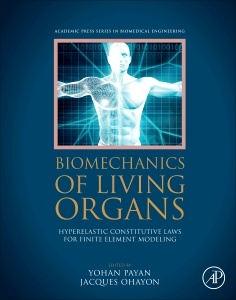Description
Biomechanics of Living Organs
Hyperelastic Constitutive Laws for Finite Element Modeling
Biomechanics of Living Organs Series
Authors: Payan Yohan, Ohayon Jacques
Language: English
Subjects for Biomechanics of Living Organs:
602 p. · 19x23.3 cm · Hardback
Description
/li>Contents
/li>Readership
/li>Biography
/li>Comment
/li>
Biomechanics of Living Organs: Hyperelastic Constitutive Laws for Finite Element Modeling is the first book to cover finite element biomechanical modeling of each organ in the human body. This collection of chapters from the leaders in the field focuses on the constitutive laws for each organ.
Each author introduces the state-of-the-art concerning constitutive laws and then illustrates the implementation of such laws with Finite Element Modeling of these organs. The focus of each chapter is on instruction, careful derivation and presentation of formulae, and methods.
When modeling tissues, this book will help users determine modeling parameters and the variability for particular populations. Chapters highlight important experimental techniques needed to inform, motivate, and validate the choice of strain energy function or the constitutive model.
Remodeling, growth, and damage are all covered, as is the relationship of constitutive relationships of organs to tissue and molecular scale properties (as net organ behavior depends fundamentally on its sub components). This book is intended for professionals, academics, and students in tissue and continuum biomechanics.
Part 1: Constitutive laws for biological living tissues 1. Hyperelasticity Modeling for Incompressible Passive Biological Tissues 2. Current Hyperelastic Models for Contractile Tissues: Application to Cardiovascular Mechanics 3. Visco-hyperelastic strain energy function 4. Constitutive Formulations for Soft Tissue Growth and Remodeling 5. Strain energy function for damaged tissues
Part 2: Passive soft organs 6. Brain – Biomechanical modeling of brain soft tissues for medical applications 7. Oesophagus – Modeling of esophageal structure and function in health and disease 8. Aorta – Mechanical properties, histology, and biomechanical modeling 9. Arteries and Coronaries Arterial – Wall Stiffness and Atherogenesis in Human Coronaries 10. Breast – Clinical applications of breast biomechanics 11. Liver – Non linear Biomechanical model of the Liver 12. Abdomen – Mechanical modeling and clinical applications 13. Small Intestine 14. Bladder/prostate/rectum – Biomechanical Models of the Mobility of Pelvic Organs in the Context of Prostate Radiotherapy 15. Uterus – Biomechanical modeling of uterus. Application to a childbirth simulation 16. Skin – Skin mechanics
Part 3: Active soft organs 17. Skeletal muscle – Three-dimensional modeling of active muscle tissue: The why, the how, and the future 18. Face – Computational modelling of the passive and active components of the face 19. Tongue – Human tongue biomechanical modeling 20. Upper airways – FRANK: a Hybrid 3D Biomechanical Model of the Head and Neck 21. Heart – Adaptive reorientation of myofiber orientation in a model of biventricular cardiac mechanics: the effect of triaxial active stress, passive shear stiffness, and activation sequence
Part 4: Musculo-skeletal models 22. Spine – Relative contribution of structure and materials in the biomechanical behavior of the human spine 23. Thigh – Modeling of the Thigh: a 3D deformable approach considering muscle interactions 24. Calf – Subject-specific computational prediction of the effects of elastic compression in the calf 25. Foot – Biomechanical modeling of the foot
Yohan Payan is Director of Research at the French National Center for Scientific Research (CNRS). In 1997, he received an award from the University of Grenoble for his doctoral research on the biomechanics of speech production. In 2012, the French Biomechanics Society awarded him the Senior Prize for his research on the biomechanics for computer-assisted surgery. His main research interests concern the biomechanical modeling of soft tissues and their integration into medical devices used to assist surgeons for planning or to guide them during surgery. The corresponding applications concern plastic and maxillofacial surgery, breast cancer treatment, neurosurgery, orthopedics and pressure ulcer prevention, based on organs or musculoskeletal models. He was a Research Affiliate at the Massachusetts Institute of Technology (1999, Boston, USA) and visiting professor at University of Chile (2004, Santiago de Chile) and University of British Columbia (2010, Vancouver, Canada). Yohan Payan is the co-head of the Biomechanics TIMC research team (Univ. Grenoble Alpes) and the Associate Editor of the Clinical Biomechanics journal (Elsevier).
Jacques Ohayon is Professor of Mechanics at the Engineering school Polytech, Univ. Savoie Mont-Blanc, France. From 1985 to 1988, he was visiting fellow at the Biomedical Engineering Branch of the National Institutes of Health (NIH), Bethesda MD, USA. He received the 1998 Junior Prize of the French Biomechanics Society (SB) for his research on the biomechanics of the left ventricle. His current research focuses on the biomechanics of atherosclerotic plaque and the development of new clinical tools for imaging the elasticity of vulnerable plaques. From 2006 to 2007, he was visiting professor at the National Institute of Biomedical Imaging and Bioengineering at the NIH, USA. Jacques Ohayon was the Chairman of the SB, which also awarded him the Senior Prize in 2016 for his work on the biomechanics of coronary p
- Covers hyper elastic frameworks for large tissue deformations
- Considers which strain energy functions are the most appropriate to model the passive and active states of living tissue
- Evaluates the physical meaning of proposed energy functions

